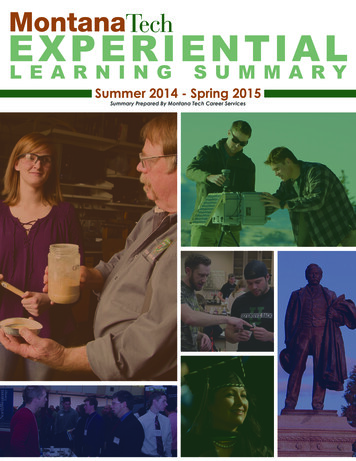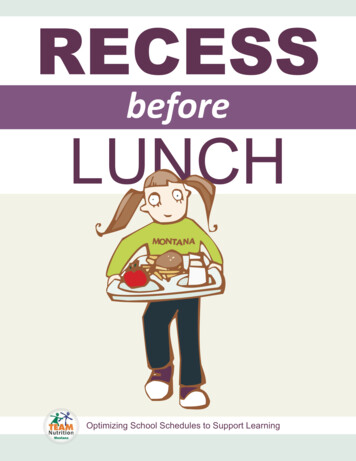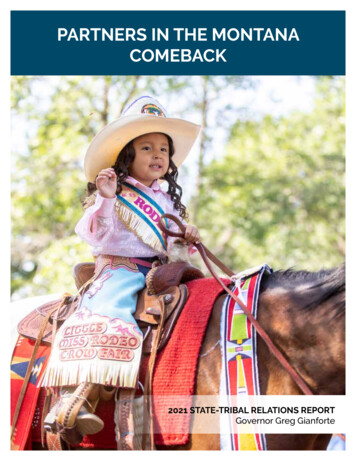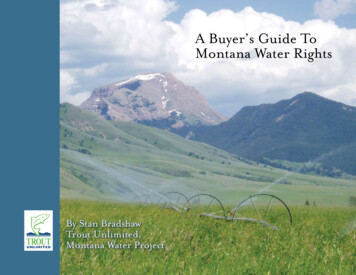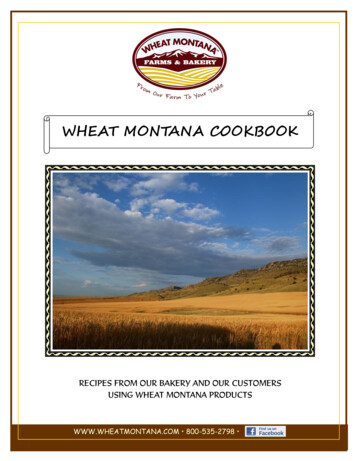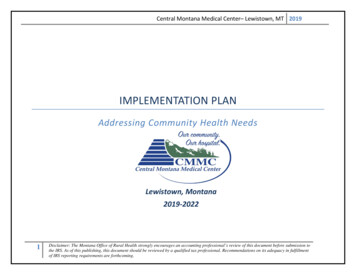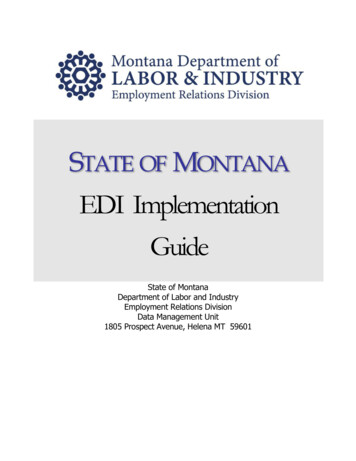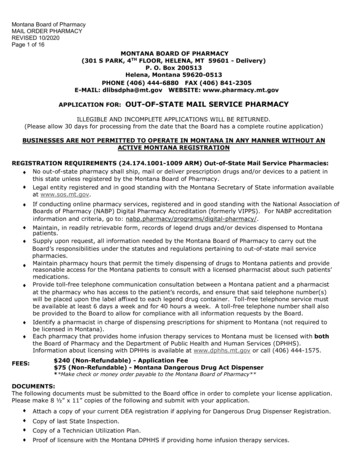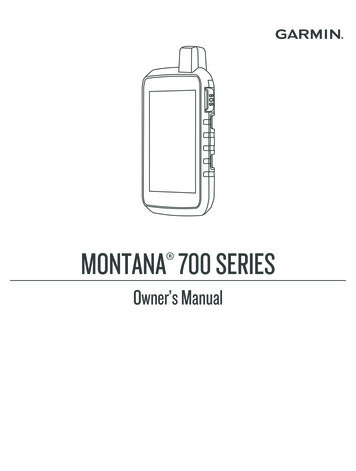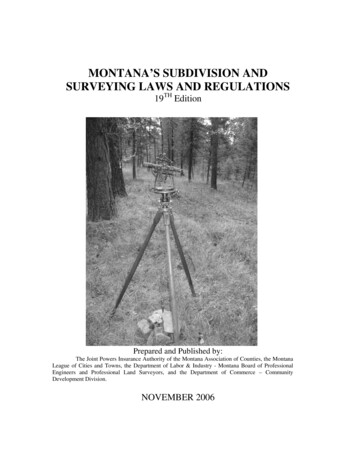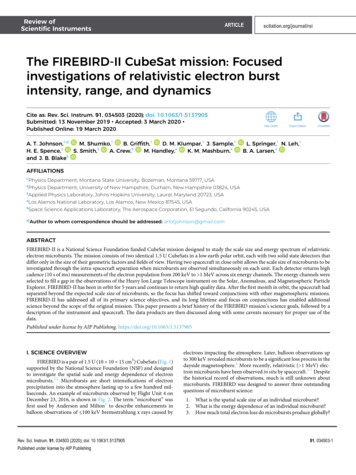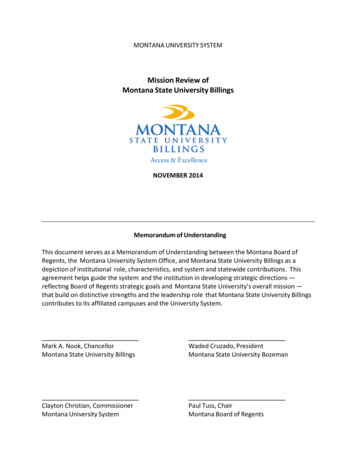
Transcription
MONTANA UNIVERSITY SYSTEMMission Review ofMontana State University BillingsNOVEMBER 2014Memorandum of UnderstandingThis document serves as a Memorandum of Understanding between the Montana Board ofRegents, the Montana University System Office, and Montana State University Billings as adepiction of institutional role, characteristics, and system and statewide contributions. Thisagreement helps guide the system and the institution in developing strategic directions —reflecting Board of Regents strategic goals and Montana State University’s overall mission —that build on distinctive strengths and the leadership role that Montana State University Billingscontributes to its affiliated campuses and the University System.Mark A. Nook, ChancellorMontana State University BillingsWaded Cruzado, PresidentMontana State University BozemanClayton Christian, CommissionerMontana University SystemPaul Tuss, ChairMontana Board of Regents
MISSION STATEMENTThe MSU Billings experience—fully embracing Access & Excellence on all levels—ischaracterized by: Strong Commitment to Teaching Excellence Support for Individual Learning Engagement in Civic Responsibility Intellectual, Cultural, Social & Economic Community EnhancementMSU Billings is an urban university serving a diverse constituency with diverse needs andexpectations. This means all areas of the university have a responsibility to enhance theintellectual, social and economic qualities of the Billings community and our students. Ourrelationships are built with people and the contributions those people make now and in thefuture. We constantly assess student achievement, community involvement andstewardship of our resources to ensure continuing educational excellence in alignmentwith goals outlined in the Board of Regents strategic plan and the Montana State University“OneMSU” concept.1.0INSTITUTIONAL CHARACTERISTICSProfileMSU Billings is a community embedded within a city, which allows the university to serve animportant niche in the region, state and in the Montana State University system. Located in the Montana’s urban center, MSU Billings has evolved into acomprehensive urban university. Programs in demand from our constituents range from short‐term workforcetraining to two‐ year degrees to bachelor’s degrees and master’s education. Through its connection to MSU Bozeman and our shared land‐grant mission, MSUBillings is committed to bringing higher education opportunities to the citizens ofMontana in a variety of dynamic and relevant formats. We mirror the diverse and evolving nature of the city, both in studentdemographics and in reciprocal relationships and partnerships throughout thecommunity.1.1RoleMSU Billings has deep connections to Billings and south‐central and eastern Montana in manymeaningful ways. We provide access to education and workforce solutions to local, regional, nationaland international constituencies through traditional, non‐traditional and general‐interest learning opportunities as well as through online formats, adult‐focusedformats and to high school students via University Connections and dual credit/dualenrollment/concurrent enrollment programs. Our reach extends to Montana’s historically underserved ethnic minorities who1.2MSU Billings Mission Review / JUNE 2010 REVISION 2
are working and living in the urban area. American Indians of the Fort Belknap, FortPeck, Crow and Northern Cheyenne reservations, and members of Billings’ Hispaniccommunity, historically concentrated on the city’s south side, are getting new accessto higher education through outreach efforts.We remain aware, agile and responsive to the diverse and ever‐changing needs ofa growing number of minority groups in the city.We are well‐positioned to partner with other entities to increase overalleducational achievement of the region.Faculty and staff are committed to providing expertise and assistance to advanceBoard of Regents strategic initiatives:o Research and graduate education, continually engaging our students inurban‐based service learning, lab experiences, turning theoretical study of asubject matter into full personal investigation and practical application.o College!Now, providing two‐year education and transfer opportunitiesthrough City College. City College serves as the comprehensive two‐yeararm of the university, providing certificates, university transfer associatedegrees, associates of applied science, and workforce developmentexperiences. Through partnerships with Billings School District 2, City Collegealso provides dual credit/concurrent enrollment, Adult Basic Education andGED access.o Transferability, ensuring student can have seamless movement betweenunits of the Montana University System.o Maintaining a strong educational pipeline, providing early access to highereducation to high school students and home‐schooled students through dualcredit, concurrent enrollment, tech prep and other early entry programs.o Distance learning, integrating technology and teaching in new formats forthe next generation of students, especially adult learners. Because 40% ofMSU Billings’ student body is over twenty-five years old, and many attendpart‐time, the flexibility provided through an online format is critical to theirsuccess as they juggle education, work and family responsibilities.Graduates in the College of Allied Health Professions are prepared to fill vitalhealthcare‐ related jobs including hospital administration, rehabilitation/counseling,human services, health and human performance services, athletic training, andoutdoor adventure leadership.Arts and Sciences graduates not only advance to masters and doctoral programs,but also provide vitality to communities in which they live, enhancing social culturaland civic awareness.Graduates in the College of Business have the marketing, accounting, finance,management and entrepreneurial skills to contribute to business and economicstability and growth in Montana.College of Education graduates are well prepared to take on challenges in all areas ofeducation—pre‐school through grade 12—in the 21st century.City College graduates have the most up‐to‐date hands‐on training and education toenter the technology, energy, trades and healthcare‐related workforce.The graduate program has had steady enrollments over the past five years, with theMSU Billings Mission Review / JUNE 2010 REVISION 3
majority of students in education, allied health and communications fields. Demandfrom the community, however, will necessitate careful planning for future growthin areas such as business, health informatics and gerontology.More than 6,500 residents enhance their lives and the community by customizededucation, short‐term workforce training and personal enrichment through MSUBillings Extended Campus.Over the past decade, MSU Billings has positioned itself as a leader in eLearning.Responding to demands to enhance access, the university developed an online presence thatnow offers 204 individual courses with twenty-four programs and nine concentrations, themost of any institution in the Montana University System. Between fall 2009 and fall 2014,online course enrollments have increased by 56% and 54.6% of our students are taking atleast one online course. This growth has helped serve the needs of place‐bound studentsacross rural Montana as well as to provide flexible options for adult learners.As a public institution, MSU Billings takes its public service role seriously and works hard tosupport two key entities located within the university, but have wide reach to thecommunity, state and region. Both are recognized by the Board of Regents and state leadersas critical elements of the university’s mission. The Montana Center for Inclusive Education (MCIE) is located in the College ofEducation building and interfaces with community organizations and COE pre‐serviceand in‐service programs. The Center serves individuals with disabilities both directlyand indirectly, of both the campus and broader communities. The MCIE has a longhistory of providing services, education and training to special needs populations inMontana and Wyoming, focusing on employment, rehabilitation counseling,transitioning, hearing conservation, community integration and collaboration. Yellowstone Public Radio (KEMC/KBMC/KYPR) provides news and culturalprogramming for more than 35,000 listeners residing in Montana and NorthernWyoming. KEMC/YPR provides valuable communication linkages to areas ofMontana not served by local news outlets. KEMC/YPR provides valuable publicaccess to the Montana Legislature and the Montana University System that wouldnot otherwise exist. Montana Regional Education Service Area 3 services for in-service educatorpreparation are provided by MSU Billings: http://www.msubillings.edu/smart/.Distinct Characteristics & StrengthsInstitutional uniqueness: MSU Billings’ greatest distinction and greatest opportunity literallysurrounds us: the city itself. Billings is the largest medical, financial and retail hubbetween Spokane, WA, Denver, CO, and St. Paul, MN. And as an urban university, strongpartnerships will continue to be imperative for MSU Billings to be efficient and effective. Students have a greater opportunity at MSU Billings to take part in cooperativeeducation, real‐ world field experiences and internships than at any other unit of theMontana University System. With three major medical facilities, three energyrefineries, major financial institutions and the state’s largest public school districtlocated in the Billings area, our faculty and our students have opportunities1.3MSU Billings Mission Review / JUNE 2010 REVISION 4
available to few others in the Montana University System.Partnerships allow us to serve the dynamic, diverse and vibrant community needs thatcould not be met by any institution or private entity alone.We are not striving to be all things to all people. We are determined to follow ourtraditional focus of being acutely aware of the community in which we reside,making us particularly nimble at developing solutions to meet local and regionalneeds.More than 40% of our students are over the age of 25, and for decades more than60% of our student body has been female.Because we are in an urban setting, a large percentage of our students at CityCollege (46%) are part‐time students, placing unique pressures on student servicesprograms there.Urban adult learners— full‐time and part‐time— are well served by the university’scommitment to alternative learning modes, online options, child care, tutoring andother student services that help them juggle work, family and educationresponsibilities.Through unique partnerships, services and programs, City College continues itstransition into a comprehensive community college.There is well‐established American Indian community in Billings and a growingHispanic community, with more of each demographic living and working in an urbansetting. Enrollment from those two groups reflects the dynamic nature of thecommunity at large. Because of its proximity to at least four American Indianreservations, the university also benefits from a strong longtime connection to tribalcolleges and American Indian leaders. MSU Billings continues to provide a forum fordiversity of ideas, lifestyles and cultures. Diversity is embraced through the MontanaCenter for Inclusive Education, student organizations or faculty and/or communityinitiatives. Awareness of diversity issues will remain an important aspect of oururban university.Connections with underserved populations on the South Side have been solidified inrecent years with our advancement of programs through a community outreachcenter at Garfield School to provide access to educational opportunities.Mirroring a state with a diverse American Indian population, MSU Billings hasdeveloped strategies to infuse Indian Education for All throughout educatorpreparation programs so that all students can better understand Montana’s culturaldiversity.MSU Billings is one of three universities in the Montana University System with anembedded two‐year college in its organization. City College has specific programswith direct relationships to the community (oil refining, energy, health care) thatreflect its urban mission.MSU Billings is the only NCAA Division II institution in Montana and fulfills animportant role in providing male and female student‐athletes with opportunitiesto compete in seventeen collegiate sports, ranging from baseball to soccer to trackand field and volleyball.MSU Billings Mission Review / JUNE 2010 REVISION 5
Core themes: MSU Billings is committed to creating an environment of academic, educationaland service excellence. With that as our focus, we have identified four core themes, whichprovide the foundation upon which the university’s 2013-2018 strategic plan has been built.Those themes are: Cultivating Teaching Excellence. Providing an Environment for Learning. Promoting and Engaging in Civic Responsibility. Enhancing the Community.MSU Billings uses its unique position, as an urban university, to fulfill Montana StateUniversity’s shared land grant mission and provide invaluable education, outreach andservices to the community as part of the “OneMSU” initiative.Strategic planning and accountability: At MSU Billings, planning, accountability and strategicinitiatives are analyzed with consideration of the Board of Regents Strategic Plan andprovide a framework for decision making at all levels. Living and working within budgetand resource constraints, MSU Billings uses all the tools in our toolbox to make well‐informed and strategic decisions. These dynamic and evolving documents can be found n.htm .Areas of CommonalitiesMSU Billings shares some commonalities with other units of the Montana University Systemin areas of education and outreach. As an institution whose primary objective is toprovide undergraduate and graduate teaching and learning experiences, MSU Billingsengages in similar educational activities as all other four‐year campuses and the researchuniversities.1.4Peer InstitutionsMSU Billings’ peers are the BA/MA Carnegie class universities in the West as established byWICHE and used by the Office of the Commissioner of Higher Education (OCHE). MSU Billingshas been identified as one of four “regional comprehensive universities” in the MontanaUniversity System. The others are MSU Northern, UM Western and UM Montana Tech.1.5For comparison purposes—especially as it relates to affordability, access andtransferability—MSU Billings analyzes its performance and outcomes as part the MontanaUniversity System and as part of the MSU family of institutions, which includes MSUBozeman, MSU Northern and the Great Falls College MSU.Also notable, MSU Billings is one of three universities in the MUS with an AACSB‐accreditedCollege of Business and one of two universities with an NCATE/CAEP‐accredited College ofEducation. MSU Billings is one of three institutions in the system with an “embedded”former College of Technology as part of the university. We often measure progress andcollaboration on that basis as well. Other embedded former Colleges of Technology are withthe University of Montana in Missoula (Missoula College) and Montana Tech in Butte(Highlands College).MSU Billings Mission Review / JUNE 2010 REVISION 6
2.0ACADEMIC PROFILE2.1 Academic ProgramsAcademics are the heart of MSU Billings, and the institution’s commitment to students andour academic profile is assessed through rigorous accreditation reviews by the NorthwestCommission of Colleges and Universities, AACSB and NCATE/CAEP. Other programs(music, art and City College technical programs) undergo accreditation reviews that arecritical for students who need to sit for licensure and therefore become eligible for jobs intheir chosen careers. The university offers approximately eighty-two degree options through its fivecolleges. The colleges—Allied Health Professions, Arts and Sciences, Business,Education, and City College—offer pre‐professional and certification programs andawards degrees at the associate’s, bachelor’s, and master’s levels. The sixth entity—MSUB Extended Campus—provides short‐term specialty educationand training for a broad constituency ranging from children to mature adults. Theunit also provides professional services in support of conferences and special events.MSU Billings also offers post‐master’s (non‐degree) supervisor endorsementprograms in Reading K‐12 and Special Education K‐12. MSU Billings offers:o fourteen Certificates of Applied Scienceo thirty-two Associate degreeso twenty-eight Bachelor’s degreeso nine Master’s degreesGeneral Education Program: MSU Billings’ general education program requires thirty-onecredits of general education classes for an AA, AS, BA or BS degree. In contrast, the MUSsystem requires thirty credits. The difference is that MSU Billings requires an additional one‐credit free‐standing lab in the Sciences. For AAS degrees, the university requires twelvecredits of related instruction work in general education including three credits in thecategories of human relations, writing, computation and technology.Faculty across the university have been engaged with the MUS transferability and commoncourse numbering initiative to ensure students have seamless transfer options within thesystem.Graduate Education Program: Graduate programs are centered on the activities ofeducating, serving and communicating. MSU Billings offers fifteen master’s degrees andoptions—six of them completely online—and is committed to ensuring all graduate studentscomplement the theoretical study of a subject matter with investigation and practicalapplication. A research course is required in all degree graduate programs.MSU Billings Mission Review / JUNE 2010 REVISION 7
Class Size Analysis, Student Faculty Ratios:Table 1Undergraduate Section Size, Fall 2014University CampusSection Size# Sections % of total2 to -99275%100 10%Total578100%City CollegeSection Size # Sections % of total2 to %100 00%Total208100%IPEDS Fall 2013 Enrollment Survey Student Faculty Ratio:City College17:1University Campus18:1Technology and InstructionMSU Billings has been a leader in online education in Montana for a decade and hastransitioned from the eCollege delivery platform to Desire2Learn (D2L) in Fall 2008. D2L isnow used for MSU Billings Online as well as enhancement of on‐site instruction. D2L is alsoused by MSU and the Great Falls College MSU. MSU Billings recognizes the importance oftechnology in teaching and learning and offers 614 courses online annually, including fullcourses for 24 degree programs. About 40% of our students are getting their educationthrough online formats, a format that fits the schedules and lifestyles of urban students.Instructional technology enhances program delivery by expanding our faculty’s ability toteach students synchronously and asynchronously through web conferencing, onlineinstruction, and audio‐video formats such as windows media or podcasting. Thusinstructional technology provides flexibility for students who have difficulty taking a class ata specific date and time and allows a faculty member to address multiple learning styles.Using technology will also allow MSU Billing to pursue innovative delivery methods (such ashybrid courses) to better accommodate adult learners.2.2MSU Billings has been proactive in moving from the old ITV systems to the newertelepresence systems. This allows our students and faculty to communicate throughinteractive video from classroom to classroom, from the D2L system to a home system, andtake part of interactive groups using WebEX – telepresence – D2L integrated together.MSU Billings has developed a unique form of the TEAL classroom by using the collaborativefurniture developed by Steelcase, Stanford, and other progressive schools and integrating theMSU Billings Mission Review / JUNE 2010 REVISION 8
functions with telepresence system on each table. Student workgroups collaborate withintheir group, with a student member at home, other workgroups within the classroom, and thefaculty member all using real-time video, audio, and desktop computer sharing.MSU Billings continues to collaborate with MSU Bozeman and OCHE staff on continueddevelopment of a more user‐friendly systematic approach to high‐speed digital delivery ofeducation as well as continued development of the Digital Community College and DigitalAcademy. Technology shifts in the future will require us to be innovative and flexible as wellas responsible with state and student resources.Alternative schedulingAs the state’s urban university, it is important for MSU Billings to be creative and flexible inmeeting the needs of students who have multiple responsibilities. Because 80% of thestudents who attend MSU Billings also work to make ends meet, the university hasbecome a leader in developing alternative scheduling and modes of delivery. The universityoffers its general education core online so students can pursue their degree requirementswhile also raising families. Some majors are also offered entirely online, in a 2 2 format(for seamless transition from another college or from the online arena), in a seven and onehalf‐week format (half of the fifteen‐week semester) and during evenings or weekends.Summer session classes contain three‐, five‐, eight‐, ten‐ and thirteen‐week options. Thesealternatives allow MSU Billings to fulfill its mission to a wide array of urban constituencies.2.33.0 STUDENTS3.1 Student Characteristics and Student ServicesLike our urban setting, MSU Billings is a melting pot. The headcount enrollment is almost5,000 students from different backgrounds and experiences and the annualized FTE is morethan 3,800. While those numbers are significant, what is truly noteworthy is the fact that onan annual basis, about 90% of our students are Montana resident students, and about 36%of those are first‐generation students, indicating our mission to serve families in thisregion of Montana continues to be important. Other noteworthy facts: 63% of our students are female and—as with other urban universities in thecountry—a majority (89%) either commutes daily to their classes or pursues theirdegree online. About 11% of our students live in one of two residence halls at the University Campus. A small, but growing, number (3%) are international students and about 18% arenon‐ Caucasian, primarily American Indian (4% of total student population in Fall2014) and a growing Hispanic population (4.6% in Fall 2014). MSU Billings had 782new freshmen for Fall 2014 and 11.6% were over the age of 24. The connection between the university and the Billings urban area — with its richarray of opportunities — attracts talented and committed students of all ages andbackgrounds. Many top students choose MSU Billings. Of those who take the ACT test, theaverage score is 21.1, putting MSU Billings students on par with those attending theMSU Billings Mission Review / JUNE 2010 REVISION 9
research universities in the Montana University System.The university annually attracts around 220 high school students to take earlycollege classes through the University Connections Program and concurrentenrollment. Of those, more than one‐fifth are home‐schooled students, of whichthere is a large contingent in Billings.Billings is a hub for veterans and their families. MSU Billings is serving more andmore veterans and their families, further attesting to its vital role as an urbanuniversity. As of Fall 2014, 380 veterans and their dependents are being served by theuniversity.Enrollment at City College campus located about seven miles west of the East Campusis experiencing dramatic growth, especially in its healthcare and trade/industryprograms. Since 2002, City College student enrollment has increased 106%.MSU Billings strives to deliver quality services to students in the classroom whilealso meeting the diverse needs of approximately 2,600 individual students whoannually enroll in distance education courses. Our online program amounted to5898 course enrollments in Fall 2014, which is up 56% since 2009.Of our graduate students, 86% are part‐time, taking fewer than nine credits.Student Services programs continue to serve all populations by integrating traditional serviceswith new initiatives. Those include: Peer Mentoring program for American Indian and other minority students through theDiversity Center.Recruitment and support services at the Garfield Outreach Center (educationalaccess point for American Indian, Hispanic and low‐income students).Revamped orientation programs for adult learners and City College students.One‐stop‐shop philosophy and evening hours to better serve all students.Expanding services at City College, including a one‐stop shop.Road-map to assist undecided freshmen in major selection.First Year Experience, Leadership and Service Learning courses offered as part ofour urban mission.Mandatory Advising for all students.Veteran’s Coordinator to assist veteran students in transition; veteran’s lounges towelcome veterans, and Veterans’ Student Club.Financial Education Success Specialist for financial literacy education and financialliteracy incorporated into the First Year Seminar course.College Success Specialists in every academic college to support students’ academicsuccess through their first year.Advanced academic/workforce training and counseling services to assist veteranstudents.3.2 Retention and Graduation RatesWork is under way to improve retention and, therefore, graduation rates. In 2010, MSUBillings entered into a partnership with Noel Levitz for Retention training and completed thetraining in 2011. As a result of the training, a focused retention plan was developed. KeyMSU Billings Mission Review / JUNE 2010 REVISION 10
strategies in the retention plan include: Identification & Tracking of Underrepresented & Targeted Populations Communication Flow to the New Freshman Cohort Academic Support Center Structures Focus on Transitions and Academic PlanningTo assist in carrying out these initiatives, College Success Specialists were placed in eachacademic college. These College Success Specialists teach the first year seminar, activelycommunicate with students about key transitions and milestones, assist students who are onacademic probation, and coach students through their first year of college.Retention of first-time full-time students in the F12 freshmen cohort at the University Campuswas 62%, up 6% from the F11 and F12 cohorts. Retention of the F12 freshmen cohort at CityCollege was 50%.Efforts continue to further increase retention rates through many of the initiatives referencesin section 3.1 above.3.3 Student Satisfaction and Student LearningOne way to measure if the university is meeting our commitment to excellence isthrough learning outcomes assessment. Assessment at MSU Billings is the responsibilityof the various departments which deal with students, whether in the academic arena or instudent affairs. Academic departments are to clearly articulate learning goals for studentsand their majors and to plan, implement and report an appropriate process for measuringhow those goals are being met. Academic leaders are responsible for reviewing results andmaking changes based on those assessments.The division of Student Affairs has developed an assessment plan that describes studentlearning initiatives sponsored or supported by student affairs departments orprofessionals. The assessment plan can be found at: http://www.msubillings.edu/VCSA/.All Service Learning courses address and assess certain student learning outcomes. Theuniversity has had early success in this area. In order to enhance service learning, theuniversity requires a civic engagement project for students taking the first year seminarcourse. This course gets students promotes an introduction to community, civic engagement,and service learning.MSU Billings’ participation in the National Survey for Student Engagement for Spring 2012and reported through the Voluntary System of Accountability program shows: 95% of seniors believe this institution provides support for student success. 87% of seniors worked with classmates on assignments outside of class. 83% of seniors rated their entire educational experience as good or excellent.MSU Billings Mission Review / JUNE 2010 REVISION 11
3.4Enrollment trends, projections, and challengesCombinedEnrollmentFall 2010Fall 2011Fall 2012533552845081Fall 2013Fall 201449694781Factors that influence our enrollment projections include: The state of the economy Program offerings Financial assistance (especially for adults and readmits) Program availability for transfer students Continued decline in high school graduation numbers in geographic areas our studentstraditionally come from Initiatives to increase the yield of high school graduates from Yellowstone County andthe surrounding area American Indian and Hispanic outreach and advancement of distance education Increased competition in the form of scholarships from MSU Bozeman and UM Missoula.Because the Billings area has four high schools and School District 2 includes nearly one inevery seven public education students in Montana, there is intense competition for thosegraduates from other universities who have more scholarship resources. Continueduncertainty about the economy, or possible quick turnaround, could also adversely affectMSU Billings enrollment as well as a perception of stagnant academic planning, lack ofunique programs we do not offer and affordability issues.Student FinancesTuition, fees and room/board rates at MSU Billings put us as one of the best highereducatio
with goals outlined in the Board of Regents strategic plan and the Montana State University "OneMSU" concept. 1.0 INSTITUTIONAL CHARACTERISTICS 1.1 Profile MSU Billings is a community embedded within a city, which allows the university to serve an important niche in the region, state and in the Montana State University system.
